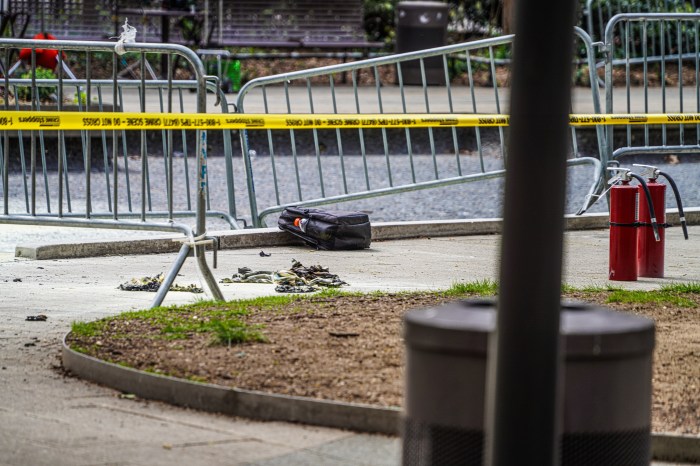Out gay filmmaker Gustavo Vinagre’s “The Blue Rose of Novalis,” co-directed with Rodrigo Carneiro, is a mesmerizing documentary about Marcelo Diorio, a gay poet in São Paulo. This film is showing only once — as part of the program “Veredas: A Generation of Brazilian Filmmakers” — and should not be missed.
Vinagre shrewdly opens — and ends — his portrait of Marcelo with images of the subject’s ass. Much of Marcelo’s candid monologues address the various things he has done with — or has had done to — it. But “The Blue Rose of Novalis” never feels voyeuristic or navel-gazing. Diorio is a fascinating, ingratiating subject. He is engaging whether rambling about his family, musing about his HIV status, or participating in sex acts on camera. Vinagre showcases him extremely well, capturing his energy and essence with penetrating close-ups as well as entertaining visual digressions.
In a recent Skype interview, the filmmaker talked about making “The Blue Rose of Novalis.”
GARY M. KRAMER: Your film opens, closes, and is centered on Marcelo’s ass. Can you talk about this narrative thread?
GUSTAVO VINAGRE: That was something that came naturally, because we also love asses and it’s a subject he likes to talk about. His stories develop all around the ass. We wanted to work on changing the hierarchy of the body in the film. That’s why it begins with the ass and the ass is upside down, and ends with him with a tunnel plug going into his ass as if we are trying to search inside of him. We wanted to work with the idea that every part of the body is important, and if the ass is important to him then the ass is important to the film. The ass is a huge taboo here and all over the world. We really wanted to talk openly about this hole that everyone has. It is really democratic in that everyone uses it, but we have this super-homophobic and religious state telling us that it’s dirty and we shouldn’t use it. We wanted to put the ass in the light so everyone can see it.
KRAMER: How did you work with Marcelo regarding what stories he told? And did you believe everything Marcelo told you?
VINAGRE: I think I believe almost everything he says. He has the soul of an actor I think —we talk about that in the film. He’s good at dramatizing his own story and that made him an attractive subject. We did create things together, like him looking at the Novalis picture and saying, “Oh, how I love myself!” So, the script was a hybrid. We defined the scenes, but Marcelo was free to tell the story however he liked. It was a really collaborative project.
KRAMER: Marcelo is HIV-positive, and the film addresses the “symbolic burden” of that as well as his family’s homophobia, gay stereotypes, and ideas of suffering and martyrdom. Was this film meant to be a form of confession or a search for absolution?
VINAGRE: That’s a great point of view. To us, it was important to start a film with the HIV-positive story. We wanted to normalize that. We’re in a moment in Brazil, one out of every four gay men is HIV-positive and no one talks about it. No one is publicly saying that I have HIV, and it’s 2019 and people have to hide that as if it is a big deal. But it becomes a big deal because people are closeted about it. AIDS is horrible in Brazilians’ minds, and there is still a great fear. We had to put it in the beginning of the film, so people didn’t think that [AIDS] is why he is this way.
KRAMER: You have some inventive scenes that divert from Marcelo’s monologue — from a funeral to images of childhood being projected on Marcelo’s masked face, to him in heels and a skirt working on a car engine. Can you talk about these scenes?
VINAGRE: It’s bringing his desires, dreams, memories, and fetishes to the surface. The images we project [on his face] reflect how Marcelo tells the story of his family and how he became what he is through his family. He’s that child still in a way. It’s Freudian. The scene with the car is also about trying to get the pieces of this family and these memories and destroy this idea of a macho man and how Marcelo built himself in opposition to this. Marcelo is so open. He knows he’s narcissistic, but he’s not ashamed of it.
KRAMER: Can you discuss the sex scenes in the film? It’s amusing when Marcelo talks to the camera while being fucked. Another sequence is a highly stylized bit in which he fellates a masked hunk who comes all over his face.
VINAGRE: The first sex scene is interesting because it is completely fake. He talks to the camera and it gets silent, so you don’t hear the guy he’s with breathing. Marcelo is saying he uses these guys and pretends that they are the best he’s ever met. He’s saying he’s in power, but he’s submissive. I felt when they hug each other there was a truth to that connection. I don’t trust what he’s saying — that he is in power with these guys. He’s projecting what he would like to have. He has this need for love and attention, and when it’s over you see this fragility. The second sex scene was more about Marcelo trying to find this catharsis that he talks about through the whole film. It’s his frustration of wanting to live in a romantic world, but he is actually living in a kitsch world.
THE BLUE ROSE OF NOVALIS | Directed by Gustavo Vinagre and Rodrigo Carneiro | In Portuguese, with English subtitles | Dec. 7 at 7 p.m. | Film at Lincoln Center, Elinor Bunin Munroe Film Center, 144 W. 65th St. | filmlinc.org



































